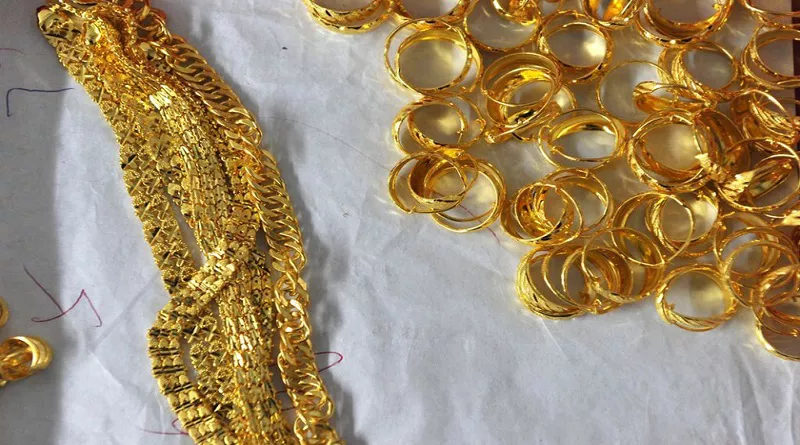Gold prices slipped as the dollar strengthened against other major currencies, with investors turning their attention to upcoming economic data that could offer insight into the Federal Reserve’s next move on interest rates.
Gold Retreats Amid Dollar Rally
In early Asian trading hours on Monday, gold was priced around $2,630 per ounce, marking a nearly 3% decline from the previous week. This fall comes amid a stronger US dollar, which gained against the euro due to escalating political tensions in France, as well as a retreat in the Japanese yen, which was weighed down by rising US Treasury yields.
A stronger dollar tends to make gold more expensive for buyers using other currencies, which can suppress demand. Additionally, higher yields on US government bonds are a negative factor for gold, which does not offer interest payments. These two factors have combined to put downward pressure on gold prices.
Impact of US Treasury Yields and Geopolitical Tensions
The recent retreat in gold prices was also influenced by a decreased demand for haven assets, following the announcement of a US-brokered cease-fire agreement between Israel and Hezbollah, which came into effect mid-week. However, despite this easing of tensions, concerns about the ongoing conflict in Ukraine, particularly in relation to Russia’s actions, continue to provide some support for safe-haven assets like gold.
Gold, often considered a store of value during times of geopolitical uncertainty, has held its ground despite recent fluctuations in the market. The ongoing war in Ukraine and rising political tensions in various parts of the world have ensured that demand for gold remains resilient, albeit at reduced levels.
Focus on US Economic Data: Nonfarm Payrolls and Interest Rate Expectations
Looking ahead, market participants are closely watching upcoming US economic data, with a particular focus on the nonfarm payrolls report due later this week. The labor market figures are expected to play a crucial role in shaping the Federal Reserve’s decision on interest rates when it meets on December 18.
Currently, markets are pricing in a 70% likelihood that the US central bank will reduce its benchmark borrowing costs by a quarter point. Lower interest rates are generally seen as favorable for gold since they reduce the opportunity cost of holding non-yielding assets like the precious metal. If the Fed indeed cuts rates, it could provide a boost for gold prices in the near term.
Gold’s Strong Year Despite Recent Pullback
Despite the recent dip, gold has had a strong year overall, with prices up roughly 30% year-to-date. This rally has been supported by the Federal Reserve’s monetary easing cycle, central-bank purchases, and growing geopolitical and economic risks. Gold’s performance this year has demonstrated its continued appeal as a hedge against economic uncertainty, particularly in light of inflationary pressures and global tensions.
Many analysts believe that gold could continue to see growth in the coming years, with some even predicting that the metal could reach new all-time highs in 2025. Both Goldman Sachs and UBS Group issued bullish forecasts last month, reinforcing expectations for sustained demand for gold, driven by a combination of low interest rates and ongoing global instability.
Other Precious Metals Follow Gold’s Decline
Alongside gold, other precious metals also experienced declines on Monday. Spot gold was down 0.4%, trading at $2,632.22 per ounce as of 10:36 a.m. in Singapore. Silver, platinum, and palladium all saw losses as well, with each metal tracking the downward movement in gold prices. The Bloomberg Dollar Spot Index, which measures the strength of the US dollar against a basket of currencies, was up 0.4%, adding pressure to the precious metals sector.
Silver, often viewed as a more volatile counterpart to gold, saw a notable drop in line with gold’s weakness. Platinum and palladium, which are typically influenced by industrial demand, also followed the broader trend, as their prices fell in the wake of the stronger dollar and rising Treasury yields.
Geopolitical Uncertainty Continues to Bolster Gold’s Appeal
While gold may have experienced a short-term pullback, its long-term outlook remains favorable. The precious metal has historically performed well during times of heightened geopolitical uncertainty, and the current global climate continues to support its status as a safe-haven asset.
The ongoing war in Ukraine, coupled with rising tensions in the Middle East and other regions, has created an environment of uncertainty that has kept demand for gold strong. Additionally, the potential for further monetary easing from the Federal Reserve, should the economic data align, could provide an additional catalyst for gold prices to rise.
Looking Ahead: A Potential Rally in Gold Prices
Gold’s recent dip in prices has not erased its strong performance in 2023, and many analysts believe that the precious metal is poised to continue its upward trajectory. With a solid foundation of support from both macroeconomic factors and geopolitical risks, gold remains one of the most reliable hedges against uncertainty.
As the Federal Reserve prepares to announce its next interest rate decision, gold’s future will be closely tied to the central bank’s monetary policy. If the Fed cuts rates, as many expect, gold could see a renewed rally. Additionally, any signs of further geopolitical escalation could add to the demand for gold as a safe-haven investment.
As we approach the end of the year, gold investors will be watching closely for any shifts in economic data, Federal Reserve decisions, and geopolitical developments that could shape the future direction of the precious metal market.
Conclusion: Gold’s Resilience Amid Economic and Geopolitical Turmoil
In conclusion, while gold experienced a decline this past week due to the strength of the US dollar and rising Treasury yields, the broader market outlook remains positive. With central-bank policies and geopolitical risks continuing to drive demand for safe-haven assets, gold is expected to remain a valuable investment in the months ahead. As investors anticipate further economic data, including key US labor market figures, the precious metal’s trajectory will continue to be shaped by a combination of economic policy and global uncertainties.
Related topics:

